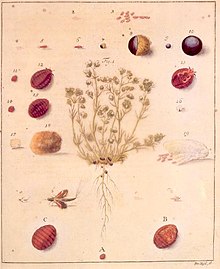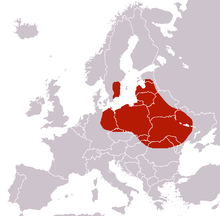Polish cochineal
| Polish cochineal | |
|---|---|
 |
|
| Life cycle of the Polish cochineal in Breyne's Historia naturalis Cocci Radicum... (1731) | |
| Scientific classification | |
| Kingdom: | Animalia |
| Phylum: | Arthropoda |
| Class: | Insecta |
| Order: | Hemiptera |
| Family: | Margarodidae |
| Genus: |
Porphyrophora Brandt, 1833 |
| Species: | P. polonica |
| Binomial name | |
|
Porphyrophora polonica (Linnaeus, 1758) |
|
 |
|
| Area where the Polish cochineal was found in commercial quantities | |
| Synonyms | |
Polish cochineal (Porphyrophora polonica), also known as Polish carmine scales, is a scale insect formerly used to produce a crimson dye of the same name, colloquially known as "Saint John's blood". The larvae of P. polonica are sessile parasites living on the roots of various herbs—especially those of the perennial knawel—growing on the sandy soils of Central Europe and other parts of Eurasia. Before the development of aniline, alizarin, and other synthetic dyes, the insect was of great economic importance, although its use was in decline after the introduction of Mexican cochineal to Europe in the 16th century.
In mid-July, the female Polish cochineal lays approximately 600-700 eggs, encased with a white waxy ootheca, in the ground. When the larvae hatch in late August or early September, they do not leave the egg case but remain inside until the end of winter. In late March or early April, the larvae emerge from the ground to feed for a short time on the low-growing leaves of the host plant before returning underground to feed on the plant's roots. At this point, the larvae undergo ecdysis, shedding their exoskeletons together with their legs and antennae, and they encyst by forming outer protective coatings (cysts) within the root tissues.
The cysts are small dark red or violet bubbles clustered on the host plant's roots. Female cysts are 3–4 millimetres (0.12–0.16 in) in diameter. Males are half the size of their female counterparts and smaller in number, with only one male per 500 females. The cysts undergo ecdysis a number of times. When the male larva reaches the third-instar developmental stage, it forms a delicate white cocoon and transforms into a pupa in early June. In late June or early July, females, which are neotenous and retain their larval form, re-emerge from the ground and slowly climb to the top of the host plant, where they wait until winged adult males, with characteristic plumes at the end of their abdomens, leave the cocoons and join them a few days later. Male imagines (adult insects) do not feed and die shortly after mating, while their female counterparts return underground to lay eggs. After oviposition, the female insects shrink and die.
...
Wikipedia
